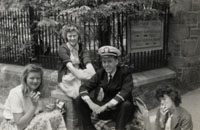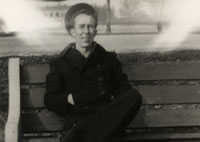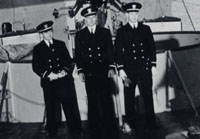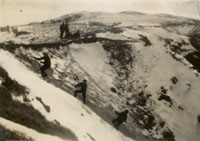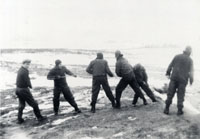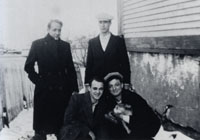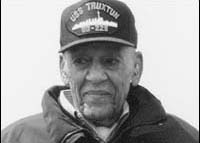Chapter 3: The Story – Dead Reckoning
Daybreak – The Truxtun
Daylight revealed the Truxtun was trapped near the middle of a crescent-shaped cove rimmed by 300-feet-tall icy cliffs. Fierce waves climbed the rock face and exploded in a great white foam; every now and then one washed over the ship and threatened to sweep men overboard. At the base of the cliff was a small beach, which lay about 250 yards from the Truxtun . If the men could figure out a way to cross the turbulent ice-cold seas that separated them from shore, then the beach would offer a place to land. Even more encouraging was a fence the men could see stretching along the top of the cliff – perhaps help was not far off.
But time was of the essence. The ocean spray and frigid temperatures had coated the Truxtun in a thin layer of ice. Not everyone had found their foul-weather gear in the chaos of the crash and many men were dressed improperly. Some had already frozen to death on the deck of the Truxtun. The sooner the men could make it to shore and find some shelter from the wind and sleet, the better their chances of survival.
The crew first tried lowering wooden lifeboats over the sides of the Truxtun. Each time a boat was released, however, a violent wave or the swaying motion of the ship slammed it against the destroyer and smashed it to bits. No luck. The sailors then turned their attention to the six rafts onboard. The first three they pushed overboard turned upside down upon hitting the water. One more became punctured on a rock holding the Truxtun in place and the final two broke up against the side of the ship.
While the rafts were going overboard, a few men discussed swimming to shore. The fuel leaking out of the Truxtun had semi-congealed near part of the beach and produced a calming effect on the churning seas. Seaman W.O. Harris and some other men felt that if they swam toward the oil, they may be able to work their way to shore. It was dangerous, but land was tantalizingly close and they all knew the destroyer would eventually break up beneath them. Harris was the first to jump overboard and others followed. Onboard, Boatswain's Mate First Class Harry Egner watched in horror as giant waves picked up the men and dashed them against the rocky cliffs. No one who entered the water survived.
On the other side of the ship, men were trying to turn over one of the upside-down rafts. If successful, they may be able to paddle it to shore with a line in tow to rig a breeches buoy. One sailor jumped overboard in a desperate attempt to push the raft right-side up, but was swept away by a powerful wave and never seen again. Stunned, the men watching onboard tried to think of a safer way to right the rafts. Ensign James Seamans suggested attaching lines to grappling hooks and throwing these overboard; if the hooks caught the far side of a raft, then the men could pull the line and flip over the vessel. After one or two throws, the men snagged a raft and turned it right side up. It was the first success of the morning.
From Ship to Shore – The Truxtun
A raft was in position in the water, but at least two men needed to paddle it to shore. Harry Egner and James Fex volunteered. Their courageousness was not lost on the other sailors, who realized that the two men were risking their own lives in a heroic effort to save their crewmates. As the volunteers entered the raft, cold water knocked the breath from their bodies. Full of adrenaline and desperation, they paddled with all of their might through the powerful waves and icy spray of the North Atlantic.
Egner realized that if they headed directly for shore, a big wave could pick them up and toss them against the cliffs – he had watched this happen to Harris and the other swimmers just a few moments earlier. Instead, Egner and Fex paddled for the open ocean, hoping the wave action would push them toward the beach, as it had pushed the semi-congealed mass of fuel near the shore. It was a sound plan – after about 30 minutes of frantic paddling, the two men reached the coastline. A cold wind knifed through their wet clothes and numbed their tired bodies, but Egner and Fex still managed to pull in the lifeline that connected them to the Truxtun and tie it around a boulder.
Hope rippled through the men watching from the ship – everyone knew their best chance of survival rested on this single line extending from ship to shore. It wasn't in a suitable position to support a breeches buoy, but at least the men still onboard the destroyer could get into liferafts and pull themselves along the line to shore. Buoyed by this success, the sailors quickly turned over the other two upside-down rafts with grappling hooks. Ten men entered one and, pulling themselves along the line, reached shore in just 15 minutes. The crew then hauled this raft back to the Truxtun using a towline that attached the liferaft to its mother ship.
But pulling an unwieldy empty raft through the fuel, waves, and debris was difficult and time-consuming work. Lieutenant Commander Ralph Hickox, captain of the Truxtun, hoped to speed things up by sending both rafts to shore one after the other and then pulling the two in at the same time. The men on the beach, meanwhile, had managed to light a small fire by using the debris that had washed up on shore and some matches one sailor had in his pocket. As they huddled around the fire, they watched the two rafts approach shore. Inside the second was Seaman Lanier Philips, who later described his voyage:
“I thought I was cold until I jumped into the water. When I hit the water, it felt as if a knife had gone through my heart. I was temporarily paralyzed from the shock. I could not move. The men on the raft pulled me onboard. I was the last man on the raft and we began to head for the beach. It seemed as if it would take many hours and I felt as if I had not slept for weeks, knowing that if I go to sleep I would never wake again. After reaching the beach I was in a semi-conscious state, and I could see this smoke from the fire and I began to try to pull myself together.” (Tape 68, 5:40-6:41)
After the men reached shore, they tied the two empty rafts to the same line and signalled the Truxtun to pull them in. Bouncing wildly over the waves and oily sludge, the rafts were impossible to control. About 50 feet from shore, they became tangled in the lifeline Egner and Fex had attached to the boulder. No matter how hard the crew of the Truxtun pulled, they could not free the two rafts.
Finally, Hickox ordered that the lifeline be untied and the entire mass of ropes and rafts be pulled back to the ship. This meant more volunteers would have to paddle a raft to shore and secure another lifeline, but there was no other choice. Orders were followed and the lifeline was untied. Everyone watched as the rafts were pulled toward the ship, but the attempt was a failure – soon after the lifeline was released, it became tangled in the rocks on the ocean floor and no amount of pulling could free it or the rafts. The men on the Truxtun were stranded. Their lifeboats were destroyed, two of their rafts were snagged on the ocean floor, and a third (the one Egner and Fex paddled to shore) lay on the beach with no towline connecting it to the ship. There was nothing they could do but wait and hope a rescue party would find them. About 24 men had made it to shore on the rafts; approximately 120 more were on the Truxtun .
While all of this was happening, two men on shore – Edward Bergeron and Edward Petterson – had been trying to climb the cliff. There was a fence at the top, so maybe there was also a farm or a house up there. Bergeron used a small knife to hack a series of handholds in the ice covering the rock face. Clinging to these, he and Petterson managed to scale the cliff. But a discouraging sight met them at the top – no farm and no sign of human habitation other than a small and very neglected looking shed. Other than that there was nothing: just a snowy wind-blown countryside stretching out as far as either man could see.
Bergeron and Petterson had brought a rope with them to the top of the cliff. They secured one end to a knob of ice and let the other end fall below; this would make it easier for other people to scale the cliff if they wished to reach the top. The two men then headed for the shed, which they discovered was empty aside from a small amount of hay. For a few moments they huddled in the shed, pressing hay around their frozen bodies for warmth. Petterson was semi-conscious, numb, and much too weak to expose himself again to the wind and sleet. Bergeron, on the other hand, had more energy and was in better health. He decided to leave the shed and jog along the coast for help. But he had no idea where the nearest community was and could only hope that he had chosen the right direction. If he hadn't, Bergeron would surely freeze to death in the snowdrifts and icy-patches sprawling out before him.
